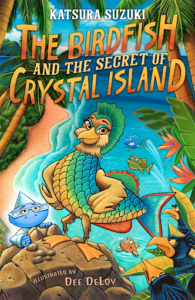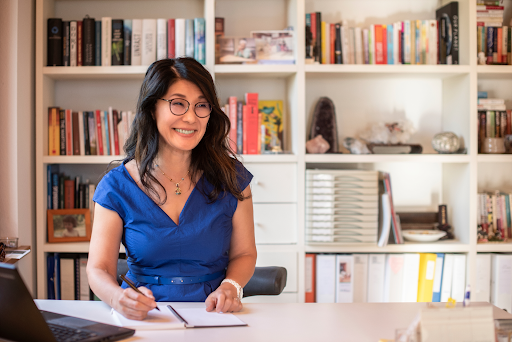 WALCHWIL, Switzerland – Feeling like a fish out of water is nothing new for Katsura Suzuki, a Japanese woman working in the financial industry in Switzerland. In her new children’s book, The Birdfish and The Secret of Crystal Island (Berry Powell Press, Dec. 4, 2022), Suzuki hopes to help kids feel confident and discover that being different is what makes them powerful. With this story, she hopes to promote self-acceptance and encourage children to create belonging and harmony for communities that are divided.
WALCHWIL, Switzerland – Feeling like a fish out of water is nothing new for Katsura Suzuki, a Japanese woman working in the financial industry in Switzerland. In her new children’s book, The Birdfish and The Secret of Crystal Island (Berry Powell Press, Dec. 4, 2022), Suzuki hopes to help kids feel confident and discover that being different is what makes them powerful. With this story, she hopes to promote self-acceptance and encourage children to create belonging and harmony for communities that are divided.
More about The Birdfish and The Secret of Crystal Island: Being half bird and half fish, Staraku has never fit in. But when she leaves her home in search of a place to belong, a mysterious crystal island and a strange new guide show her that what makes her different makes her more powerful than she ever imagined.
When Staraku learns her island is on the brink of destruction, she must make a choice. Will she let the birds and fish who rejected her fend for themselves? Or will she use her new power to try to save them and bridge an impossible divide?
“The Birdfish and the Secret of Crystal Island”
Katsura Suzuki | Dec. 4, 2021 | Berry Powell Press | Middle Grade Fiction
Paperback | 978-1-7363953-4-9 | $9.99
Ebook | 978-1-7363953-5-6 | $4.99
More about KATSURA SUZUKI

Having lived in both the East and West, Katsura Suzuki, MBA, DBA, has over thirty years of experience in Swiss-based consulting and wealth management business plus thirteen years of formal training in Japanese meditative arts.
Katsura revolutionizes the field of global leadership development by introducing a science-based, results-oriented mindfulness method called The Invisible Gift. Her unique and timely message empowers adults and children to thrive in an increasingly globalized world through her children’s book, The Birdfish and the Secret of Crystal Island and her adult book, The Invisible Gift. Learn more at drkatsurasuzuki.com.
In an interview, Katsura can discuss:
- Her experience as a Japanese woman doing international financial business independently in Switzerland and how that plays into her writing
- How her multicultural background impacted the themes of Birdfish
- How this book can help kids coping with feelings of rejection or bullying
- Helping kids find self-acceptance and value in their differences
- Why respecting nature and the world around us is so important and how kids can incorporate this into their lives
An Interview with Katsura Suzuki
1. Who is The Birdfish written for?
The Birdfish is primarily for kids who don’t quite fit the mold—like me. Perhaps they’re from a multiethnic background, they’ve moved around a lot, or there’s some other reason they just feel a bit different. I think everyone can relate to this in some way. In an increasingly globalized world, we all find ourselves wondering, “Who am I?” and “Where do I fit in?” at some point.
The Birdfish exists to help those kids find their freedom and purpose in being exactly who they are. Rather than covering up their differences, this book is meant to reveal their quirks and differences as the source of their strength.
2. How do you relate to Staraku in The Birdfish?
The story of The Birdfish is incredibly personal to me. In fact, it’s my story.
I am an only child, born and raised in Japan. Growing up, everyone knew me as “the tea ceremony master’s daughter” and assumed I would follow in my mother’s footsteps to become a master myself. So, at the age of five, I started my training. I sat still and quiet for hours at a time learning the ritual of making and serving tea. While I was supposed to be meditating, I actually spent most of those hours wishing I were anywhere else. I never quite fit the mold.
As soon as I could, I left Japan on a mission to find my own purpose. I moved to the US and eventually Switzerland, where I started my family and spent the next thirty-five years in Swiss-based financial advisory services. Both my kids are both biracial and bicultural. My work, my family, my life—it was all a blend of East and West. But at work, I was a Japanese woman constantly surrounded by Swiss men. And in Japan, I was the one who had left rather than becoming an esteemed tea ceremony master like my mother. In both East and West, I never fully felt like I belonged.
It wasn’t until I hit a crisis that I started having these vivid dreams. In them was a half-bird, half-fish creature with a funny little mentor who helped her find her power. Seeing her made me feel like I finally understood myself. I woke up and started writing. Those dreams became the basis for this book.
These dreams prompted me to start meditating again—this time for myself, not to please my parents. In meditation, I remembered the lost lessons of my childhood. Having cast them aside long ago, I asked those lessons to guide me again.
It was only then, when I began to embrace both parts of myself, that I began to feel whole.
The same is true of Staraku. Only when she fully embraces both parts of herself does she unlock her greatest power—to create her own sense of belonging, and to create belonging for others around her.
3. What are the major lessons Staraku learns from her mentor in the story that can apply to kids reading this book?
The major lessons Staraku learns from her mentor are based on the four principles of the Japanese tea ceremony: tranquility, purity, respect, and harmony.
- Tranquility: When others target you for being different, you can place boundaries around yourself that allow you to create your own sense of safety and calm.
- Purity: When we’re hurt, we can hurt others without realizing it. When we’re honest enough to recognize the ways we’ve hurt others too, we have purity of heart.
- Respect: Rather than being afraid of others’ differences, we must recognize their differences are what make them special and give them their unique purpose.
- Harmony: When we live into our purpose, we create a safe, welcoming space where everyone can belong, no matter how different they are.
Staraku learns all of this with the help of her new friends. Ultimately, these lessons allow her to embrace her uniqueness and turn her island into a place of harmony rather than conflict. When kids embrace these lessons, they also create harmony in the diverse world around them.
If anything, I felt more lost than before. For every country I spent time in, I took a piece of it with me. Rather than finding my home, my life became more globalized and complex until I surely didn’t fit in anywhere.
However, I learned so much from each culture I spent time in. I used to resent the challenges of being a global citizen, but my global worldview turned out to be my secret power. In work and in my personal life, when I embraced all different parts of myself, I was able to create a bridge between different worlds.
My writing melds Eastern and Western ways of thinking as well. While the Birdfish is written in English for a mostly Western audience, it’s rooted in the principles of the Japanese tea ceremony, and the name of the mentor figure has German roots. I think kids from around the world will each find something from The Birdfish they can see in their own story.
5. The theme of feeling like you are different is prevalent in this book. What are some challenges you face as a woman in the male-dominated financial world?
Being a Japanese woman in a heavily male-dominated financial world, I’ve often felt like a TV that’s constantly changing channels. I’ve spent so much of my life “changing channels” in order to make myself fit in. The higher up you go in the food chain, the more intense the feeling is.
I’ve had to change the way I communicate to be seen as authoritative. I’ve downplayed my Japanese roots to avoid being seen as exotic. I’ve had to learn how not to be taken advantage of just because I’m open and kind. I’ve had to become very, very flexible, bending this way and that to fit in every situation.
While using so much energy just to fit in, I forgot who I was as a result. It’s taken me a long time to rediscover who I really am. After decades of struggle, I’ve learned to embrace my differences again. I’ve learned to use my differences as a competitive advantage. But I feel the pain of those still “changing channels,” and I teach others with similar stories to turn their disadvantages into their strengths.

A former award-winning journalist with national exposure, Marissa now oversees the day-to-day operation of the Books Forward author branding and book marketing firm, along with our indie publishing support sister company Books Fluent.
Born and bred in Louisiana, currently living in New Orleans, she has lived and developed a strong base for our company and authors in Chicago and Nashville. Her journalism work has appeared in USA Today, National Geographic and other major publications. She is now interviewed by media on best practices for book marketing.

